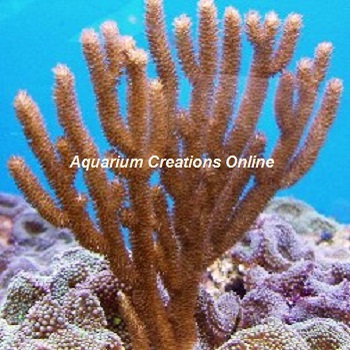Golden Sea Rod is one of the easiest gorgonians to keep. It grows in a vertical, tree like formation. Coming from the shallow waters of the Caribbean and Western Tropical Atlantic, the branches are Rusty yellow in appearance and have a bumpy texture when the polyps are not expanded. When the polyps are open they are a beautiful golden yellow. It has numerous long polyps on thick branches that are the same size from the tips to the bottom. The tips are nicely rounded off and club like. Colored in a tan with tons of yellow to gold polyps. With a dichotomous structure which is a random “Y” shaped branch pattern, as well as a lateral structure that are simply extensions from the main branches in the middle, the branches grow in various directions, but seem to eventually curve upward. Other descriptive names for the Golden Sea Rod Gorgonian is the Golden Bushy Gorgonian, the Golden Sea Rod, Sea Rod, and Sea Whip.
The Golden Sea Rod is a photosynthetic gorgonian found in the Western Atlantic near Florida, the Gulf of Mexico and the Caribbean. Golden Sea Rod's have a central “chord” that is the main branch that the rest of the coral grows from. The structure is covered by a rind, which is a tissue layer, and there are polyps on raised areas of the rind. The rigid structure of branches consists of a protein substance called gorgonin, thus the family name. Golden Sea Rod Gorgonians can be attached to rockwork using underwater epoxy.
Difficulty
Fairly Easy to care for as long they have the necessary light and water movement.
Aggressiveness Very peaceful, poses no threat to any other corals or gorgonians. However, other gorgonians can over take the Golden Sea Rod Gorgonian, so they will need to be kept at a distance. Adequate space should be provided between them and other corals that can extend sweeper tentacles as well.
Waterflow
Requires a moderate to strong level of water flow.
Lighting
Since they take nutrients from the marine algae, zooxanthellae, they share a symbiotic relationship with, they will need moderate to strong Reef lighting. It has been shown that lighting that has 350 to 550 nm , which is the blue phase, is the most beneficial.
Placement
Place anywhere which provides the required water flow and good lighting level.
Diet and Feeding
Omnivore - These gorgonian corals have developed several feeding strategies. They capture planktonic organisms and microscopic food particles from the water column, and can absorb dissolved organic matter. Unlike a lot of other Gorgonians, the Golden Sea Rod has a symbiotic relationship with a marine algae known as zooxanthellae, where they receive some of their nutrients.
In captivity, the Golden Sea Rod can be fed enriched Artemia nauplii, rotifers, dust-sized pellet food, copepods, daphnia, and other similar sized foods. Marine Snow many also be a good food source. Stirring the substrate to suspend edible particulates is helpful, along with the presence of fish which can also help nourish it. Feed every other day depending on appearance
|



